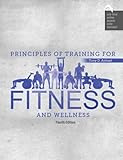Fitness Training Principles
These fitness training principles broadly apply to a variety of athletic training programs and can be applied to any specific training program.
Stay in shape all year or it will be more difficult to get into shape and harder on your body than if you stayed in shape throughout the winter. Additionally, you will be more likely to injure yourself when you pick up your fitness training routines again.
Set Goals. Set your fitness goals based on why you are training. As you develop and focus in on your primary goal, you will likely develop several secondary goals, and develop both short and long-term goals. Rank and prioritize as general goals, long-range goals, season goals, and monthly goals. This will give you a way to measure incremental training progress, help motivate you and be more fun as your climbing technique improves throughout the season.
Each workout should be geared to a specific purpose. Divide your workout into three distinct warm-up, workout, and cool-down phases.
Warm-up and Stretch. It only takes 15 minutes of light exercises to increase muscle blood flow and your body temperatures. Don't skip this step - a good warm-up and stretching session will reduce the possibility of injury.
- Warm up your whole body. Slowly stretch and move your muscles, tendons, and ligaments. Increase the force of your muscles, slowly increase your pulse, and blood flow. Work toward flexibility.
- Do stretching exercises and apply light muscle strain to your muscles. This will increase your flexibility and prepare your muscles for climbing.
- Increase the level of warm up to include your major muscle groups. So one or two pull-ups, jumping jacks, pushups, and short jogging in place. Keep increasing the pace until you just break a sweat. Finish your warm up with stretching exercises.
The Workout. For each workout, pick and target a specific skill that you need to improve. Decide ahead of time what you will work on. The key is to focus on a specific aspect of your training during a specific workout.
- Work your specific training goal in the same intensity that you climb when climbing for your primary goal. Make your workout realistic.
- Hard tenacious training prepares you mentally for climbing. Whatever the specific skill you are developing during the workout, you should keep the pace and intensity as you would during a climbing competition or real rock.
- Don't Overtrain. If you have a session where your body is telling you "No!"… listen. Your body needs recovery time. See the section on How Muscles Work to understand the recovery process. Too much training can be just as limiting to your progress as inadequate training. Additionally, you will increase your risk of injury if you overtrain - that could cost you months, or even a season.
Cool-Down. The cool-down is essential to complete your workout. Your cool-down should last about as long as your warm-up - 15 minutes. It is basically a reverse of the warm-up. Gradually decrease your exercise intensity. Cool-down by light calisthenics, stretching and walking.
- During high intensity exercise, lactic acid builds up in your muscles and they become tight. Your muscles must be stretched and moved to your body remove the excess lactic acid.
- Your heart rate was probably at near-maximum after a hard workout. You need to let your pulse come down gradually.
Conclusion. Decide what you want out of climbing, then pick a training program that will meets your goals. During training, pick one area and focus on it during your workout. Train hard - don't lower your training intensity but if it hurts, back off - don't overtrain. Keep your training plan up all year. This will keep you in better shape mentally and physically, reduce the potential for injury, and will result in higher strength, endurance, and aerobic capacity.
References:
- Youth Strength Training
- The Fit-Or-Fat Target Diet
- Encyclopedia of Nutrition and Good Health
- Stay-Fit Bug Exercises Ebook$0.99 Kindle download.











